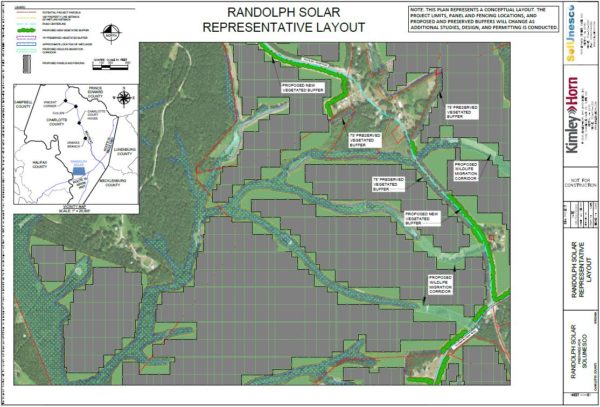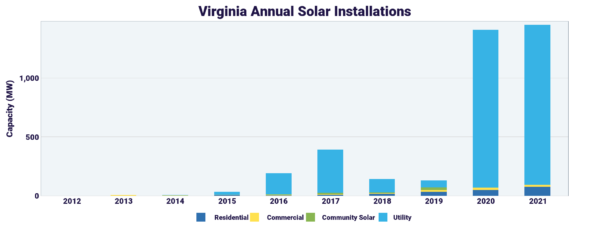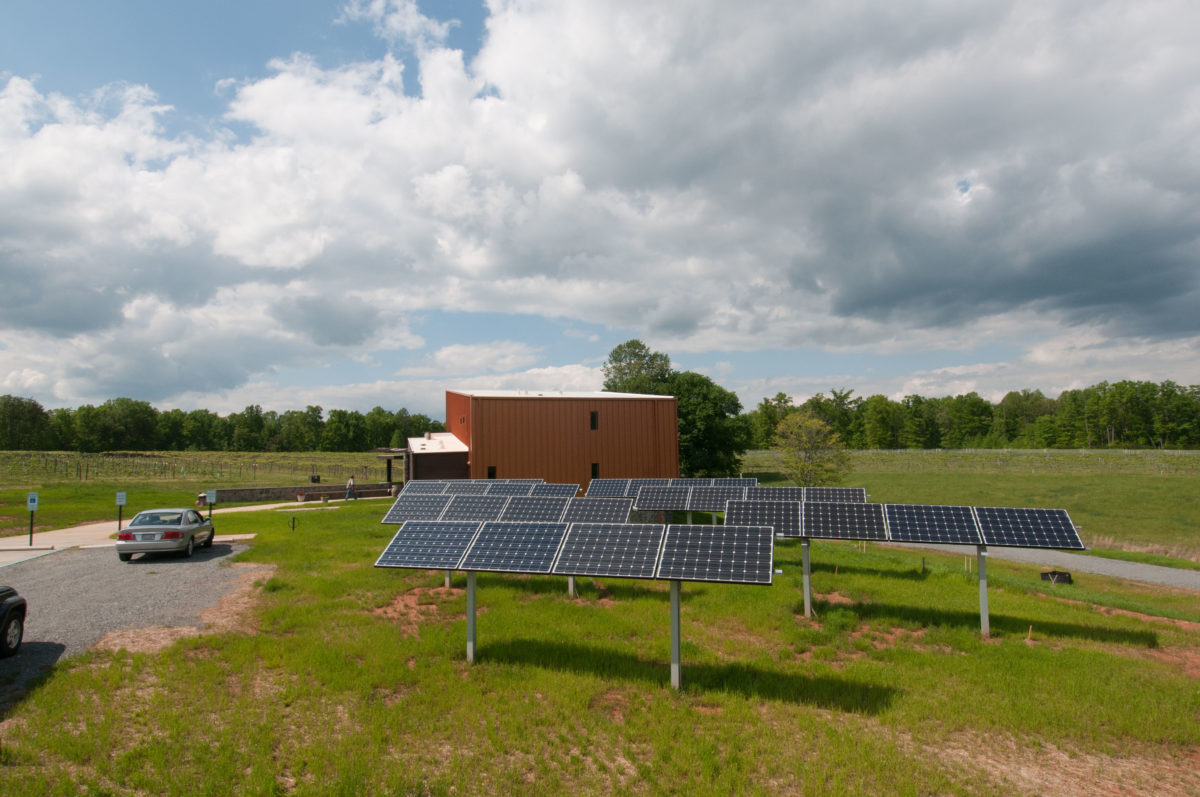Over the last three years, Virginia pivoted its energy policy, centering it squarely on solar and wind energy buildout. The Department of Environmental Quality set a target of 5.5 GW of renewable energy, at least 3 GW of which should be under development by 2022. In the last two years, the state has deployed gigawatt-scale capacity in solar, dwarfing years past.
Virginia targets 30% renewable energy by 2030, and 100% by 2050. While much of the buildout thus far has been at the utility-scale, the state also has significant incentives for solar and energy storage at the residential and commercial levels.
Incentives
Virginia employs a traditional net metering program, meaning a solar customer will receive credit on their bill for any excess electricity sent back to the grid. A full retail rate is paid to all residential customers with systems under 20 kW. Non-residential projects can receive retail net metering up to 1 MW, and agricultural customers up to 500 kW.
Virginia, like many states, also has a property tax exemption for solar taxes. Although the price of a home will likely rise after going solar, Zillow estimates an average of 4%, property taxes will not be assessed on that value increase. Earlier this year, the residential property tax exemption lifted its system size to 25 kw.
In 2020, the Virginia Clean Economy Act was passed, which mandates the state via a renewable portfolio standard to have at least 1% of its energy from solar resources. To encourage this, the state set up a solar renewable energy credit (SREC) program. For each megawatt-hour produced by a system, a credit is assigned to a solar customer. Virginia SRECs are currently valued at about $50 a month, and the price ceiling is $75.
The Virginia Clean Economy Act was a big step for the state’s energy transition. It is expected to create up to 13,000 jobs per year, produce nearly $70 billion in net benefits for residents, and generate up to $3,500 in savings for each household over the next 30 years. It also placed a cap on electric bills, closed loopholes on energy monopolies, and added energy efficiency programs for marginalized communities.
Federal incentives will further boost the value of solar for Virginians. The Investment Tax Credit was recently extended for the next decade at 30%. The credit also applies to battery energy storage.
A full list of solar and clean energy incentives can be found here.
Shared solar?
Another policy development this year that solar advocates found issue with was the establishment of a “shared solar” minimum bill of $55 a month. Shared solar, similar to community solar, allows customers to sign on for a portion of off-site solar generation when rooftop solar is not a suitable option. The $55 minimum bill is the highest in the nation by a good measure.
The approved legislation also set the rate for bill credits under the program. Customers are paid $0.11765/kWh; however, customers of Dominion Energy pay upwards of $0.124/kWh for traditional electricity, and rates are steadily on the rise. Generally, community or shared solar programs offer bill savings or at least price parity with the market, but under this program, the economics aren’t particularly attractive to residential customers.
“We did not pass legislation to create a program that exists in name only,” wrote a group of solar-supportive state senators in a letter to the commission. “(The shared solar program) should be implemented with an underlying assumption that the program needs to work. A competitive shared solar program is a new and exciting frontier for Virginia, and we recommend taking serious consideration of the input provided by industry and advocates with regards to what has proven successful in other markets.”
Dominion argued the high charge is designed to offset the “cost shift” that non-participants would receive as a result of the program. The company has not yet provided evidence of how much of a cost shift would be borne by non-participants.
The “cost shift” argument is standard in the monopoly utility playbook for quashing distributed solar projects and third-party participation in their territories. Read about California’s struggle with the cost shift argument and a debunking of its false assumptions here.
“It is correct that the record does not include evidence that specifies exactly what cost shift would occur under Dominion’s proposed minimum bill, or any of the other proposed minimum bills,” wrote SCC Hearing Examiner Mathias Roussy.
Notable project
Though not yet installed, the most notable project in the state stands to rank among the largest solar facilities in the world. The Randolph Solar project is an 800 MW renewable energy producing titan with an estimated value upwards of $800 million. This July, Officials in Charlotte County, Virginia have voted to grant a conditional use permit to SolUnesco’s planned project, which is set to be developed on a 21,000-acre footprint across the southern portion of the county.

Construction is planned for the second quarter of 2025 and may take a crew of 700 workers up to 2 years to complete. The project is expected to generate $311 million in revenues for the county over its 35 year planned lifespan. While the permit has been granted, SolUnesco still needs approval by the State Corporations Commission, which the company is expecting in 2024, after it has performed environmental impact studies, as well as other pre-construction site and viability assessments.
Deployment
Solar is increasingly an important part of Virginia’s grid. As of Q1 2022, the Solar Energy Industries Association (SEIA) reports the state has deployed about 3.8 GW of solar capacity. This would rank it 10th in the nation in terms of deployment. It ranked 4th in the nation in 2021, buoyed by utility-scale projects.

The state is home to 179 solar companies, nearly 5,000 jobs, and has invested over $4 billion in solar technology to date, said SEIA. There are 28,095 solar projects installed in the state, and SEIA projects another 4.1 GW will be installed over the next five years.
There is currently enough solar energy to power over 427,000 homes in Virginia, making its way to the goal of all 3.6 million homes being powered by renewables by 2050.
Our last stop in the pv magazine USA 50 states of solar tour took us to West Virginia, and next we’ll be headed to North Carolina another solar leader on the eastern seaboard.
This content is protected by copyright and may not be reused. If you want to cooperate with us and would like to reuse some of our content, please contact: editors@pv-magazine.com.









By submitting this form you agree to pv magazine using your data for the purposes of publishing your comment.
Your personal data will only be disclosed or otherwise transmitted to third parties for the purposes of spam filtering or if this is necessary for technical maintenance of the website. Any other transfer to third parties will not take place unless this is justified on the basis of applicable data protection regulations or if pv magazine is legally obliged to do so.
You may revoke this consent at any time with effect for the future, in which case your personal data will be deleted immediately. Otherwise, your data will be deleted if pv magazine has processed your request or the purpose of data storage is fulfilled.
Further information on data privacy can be found in our Data Protection Policy.